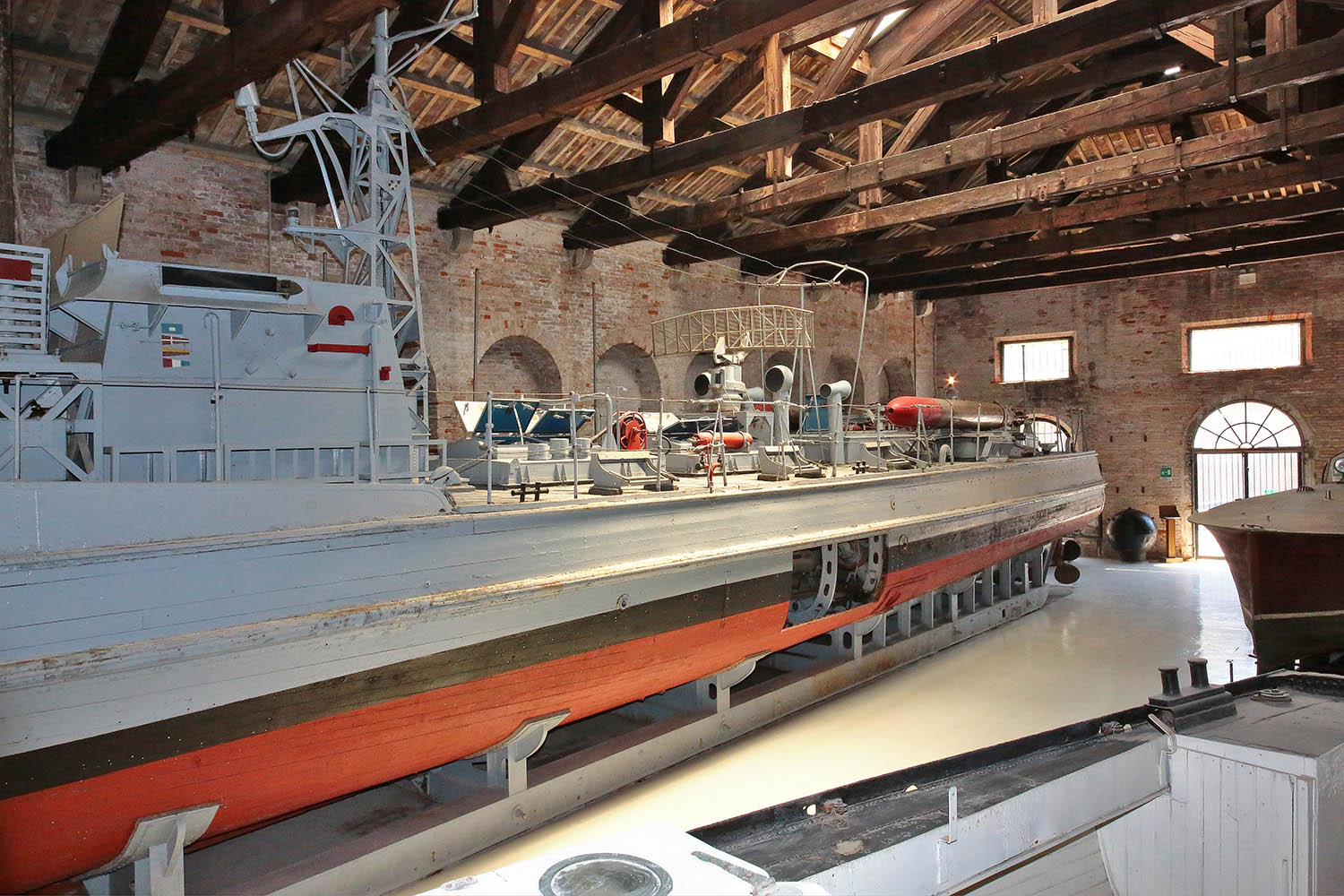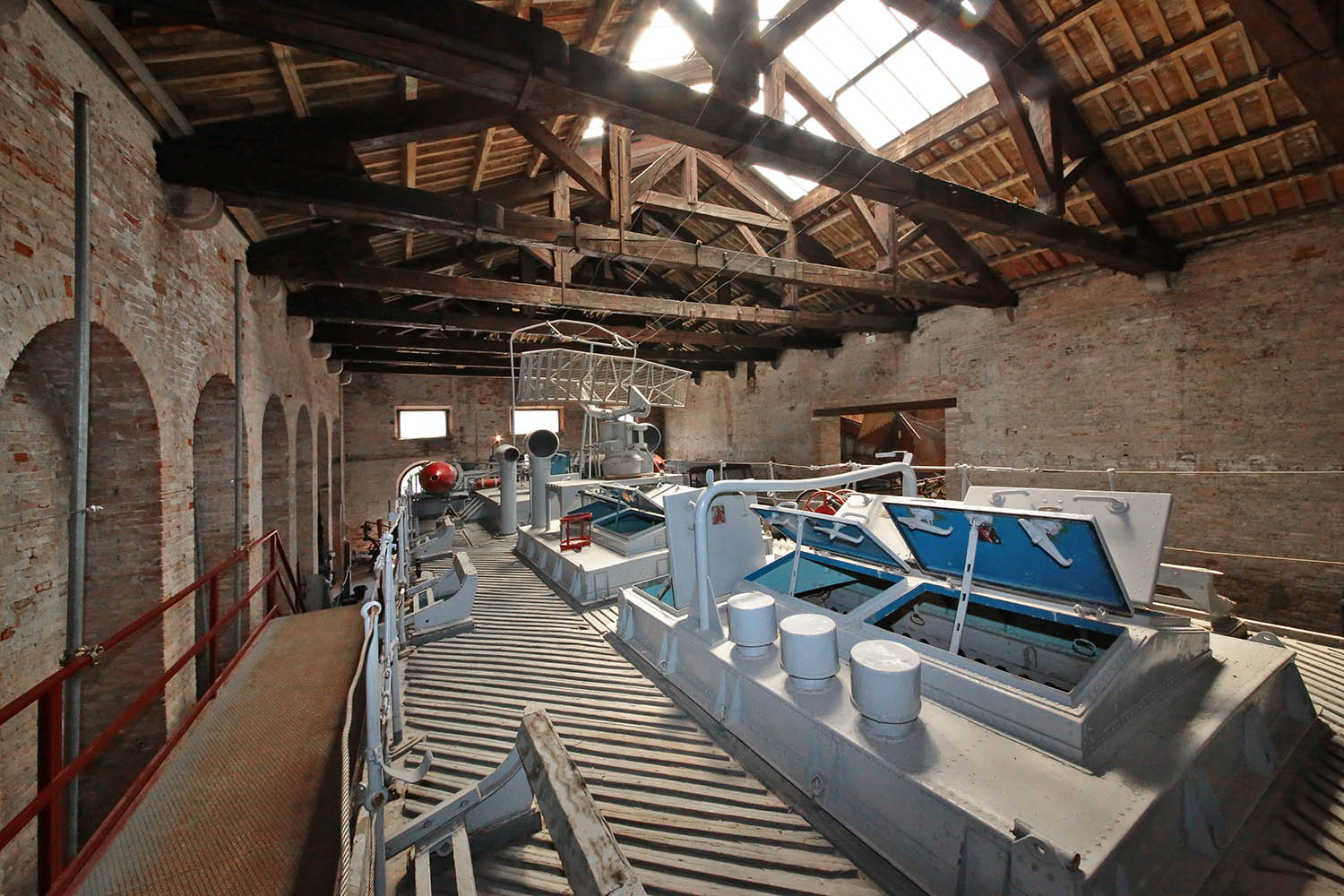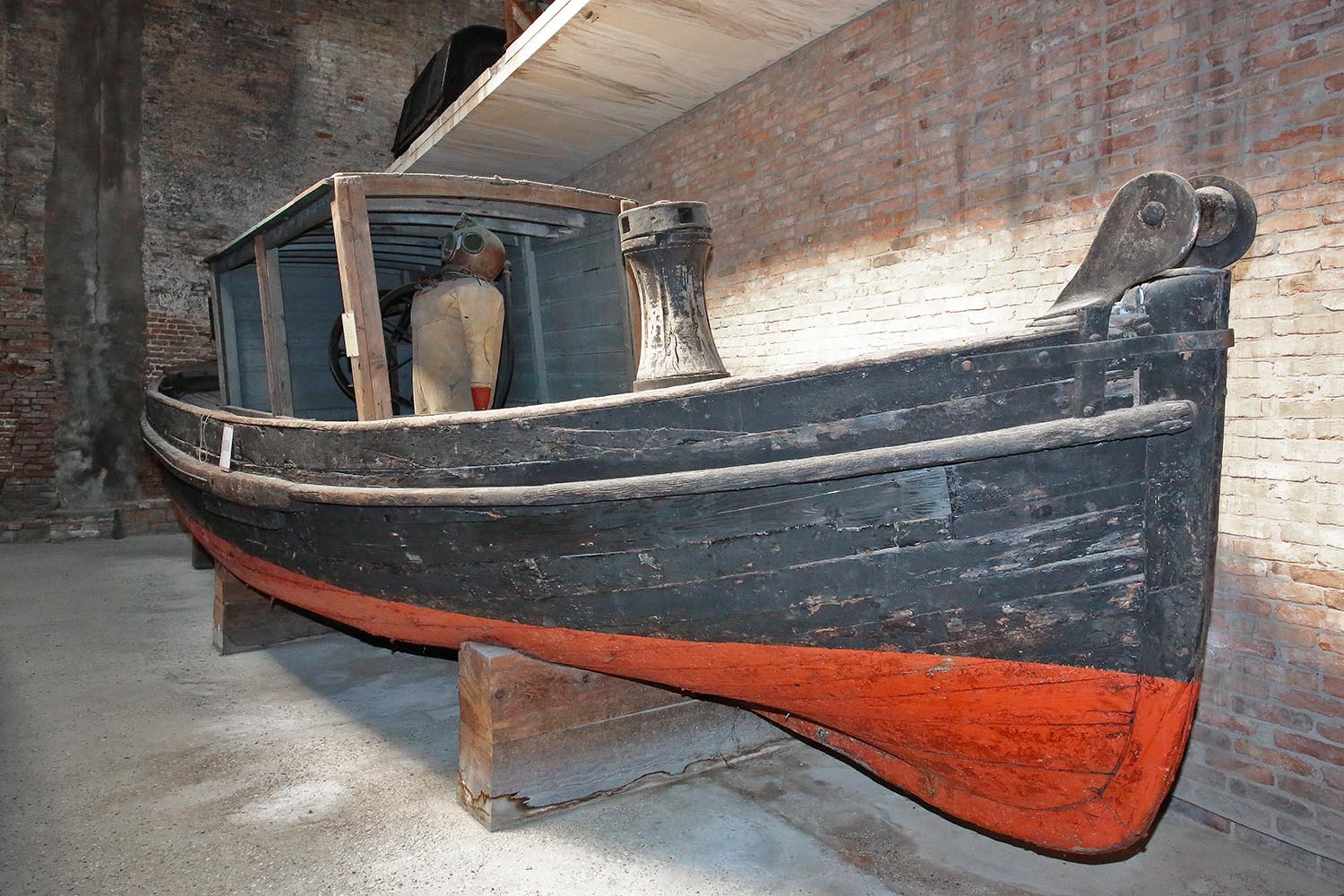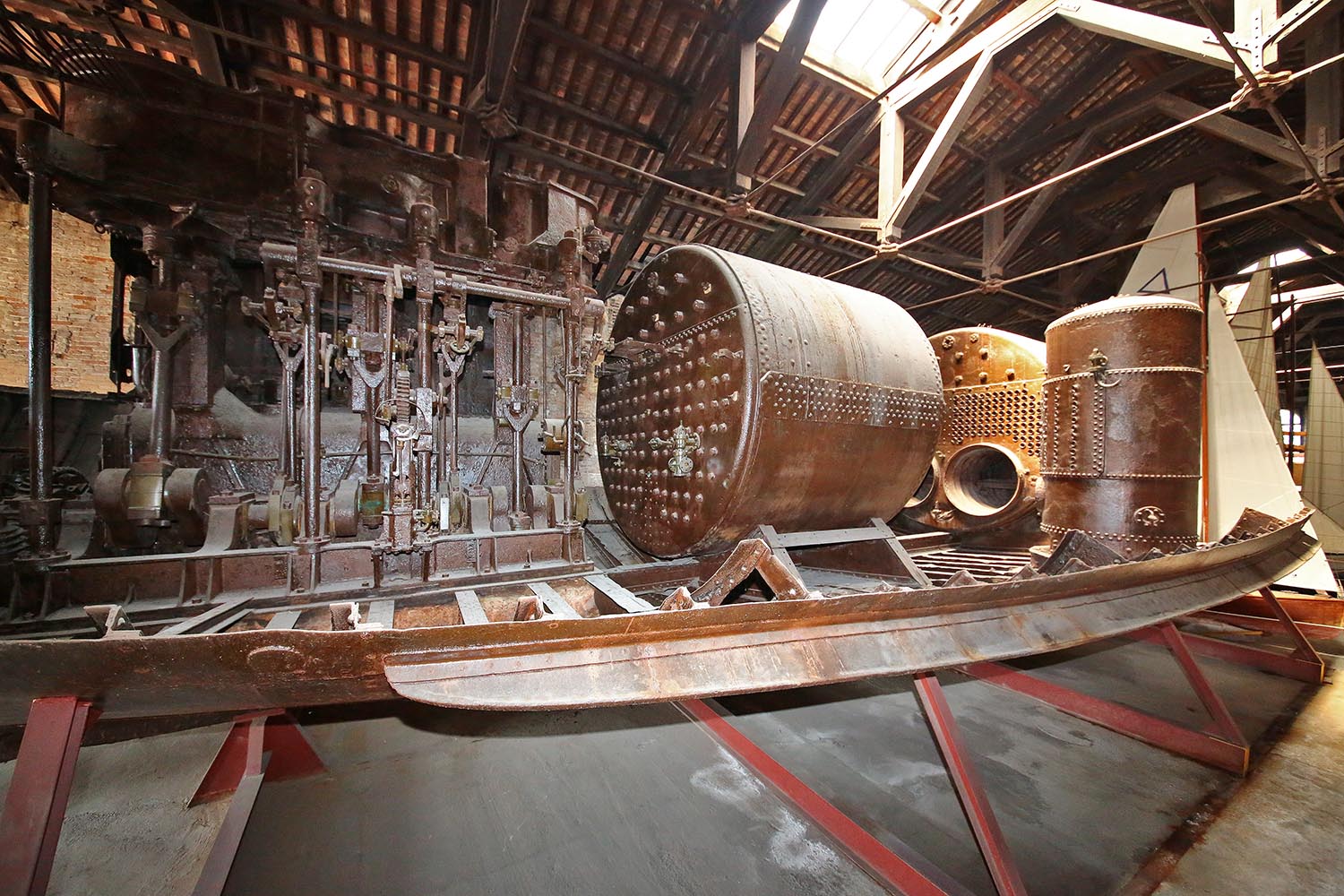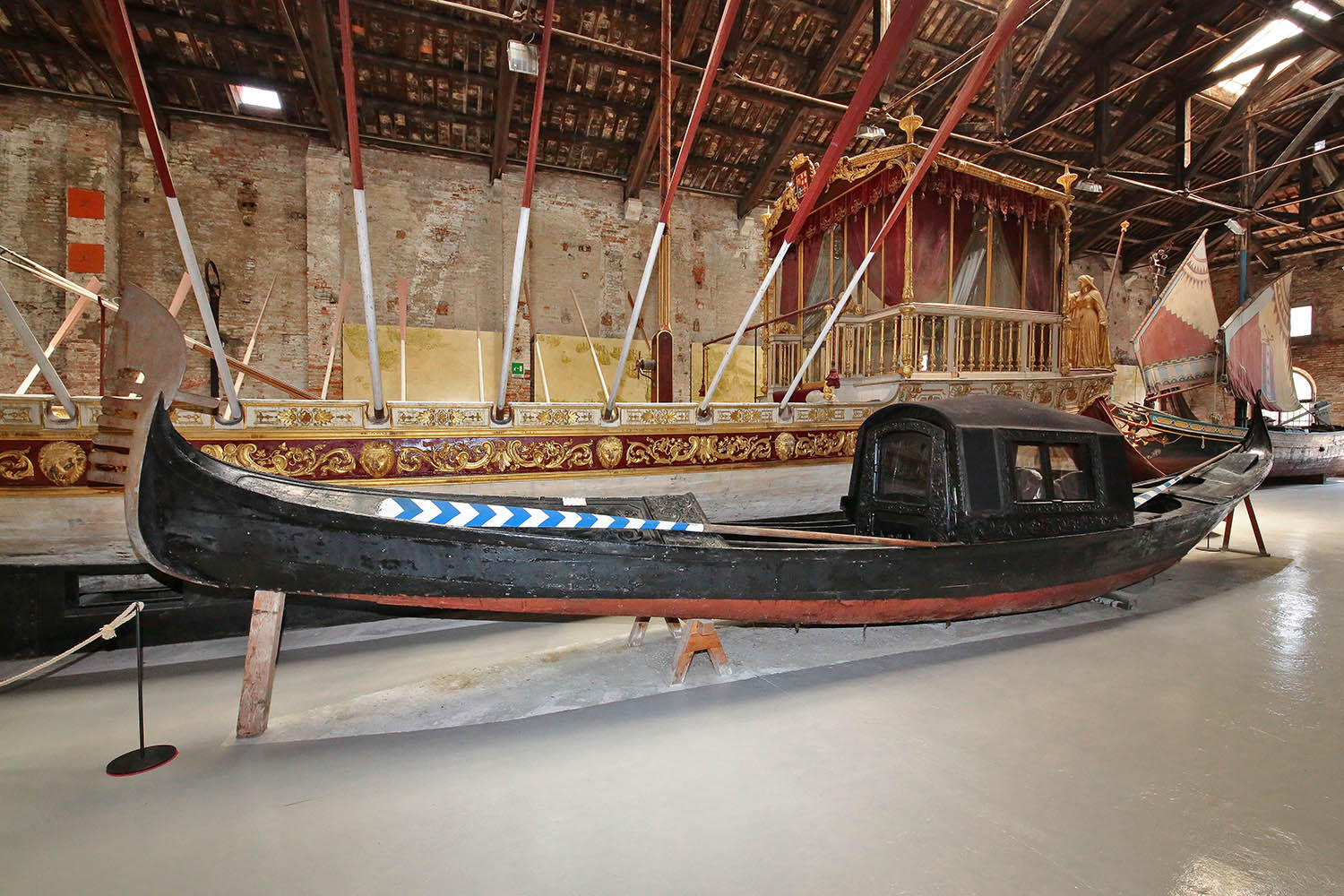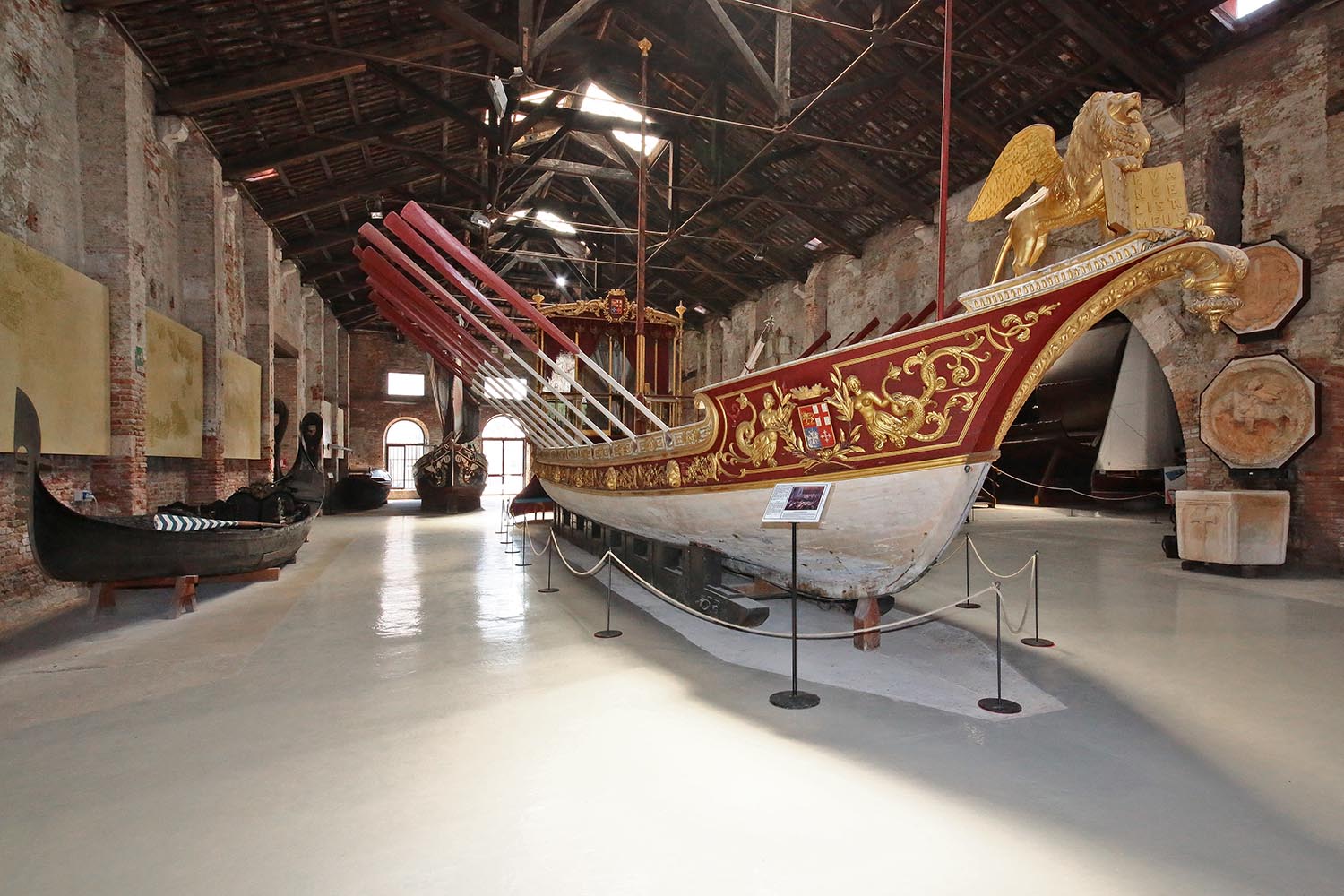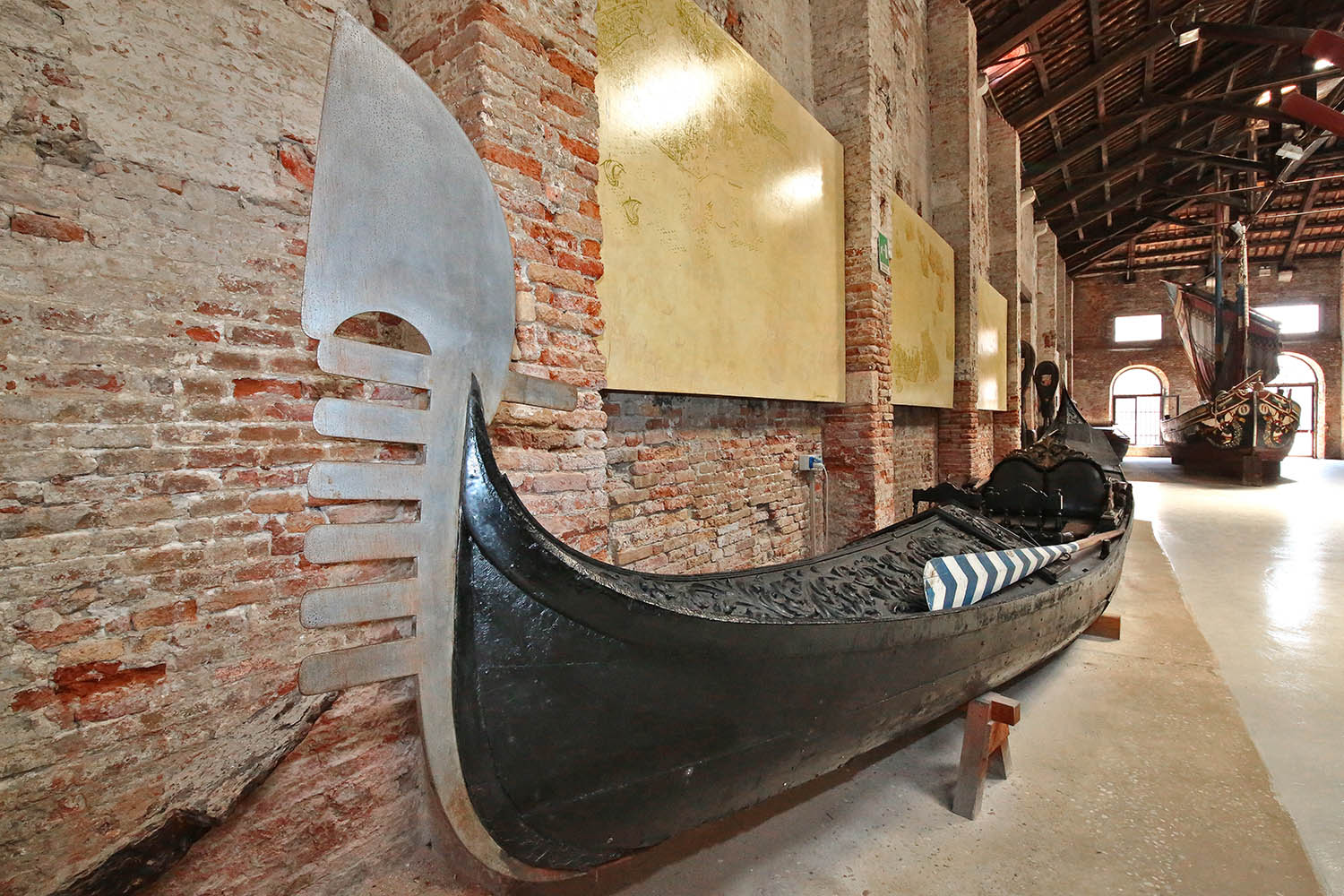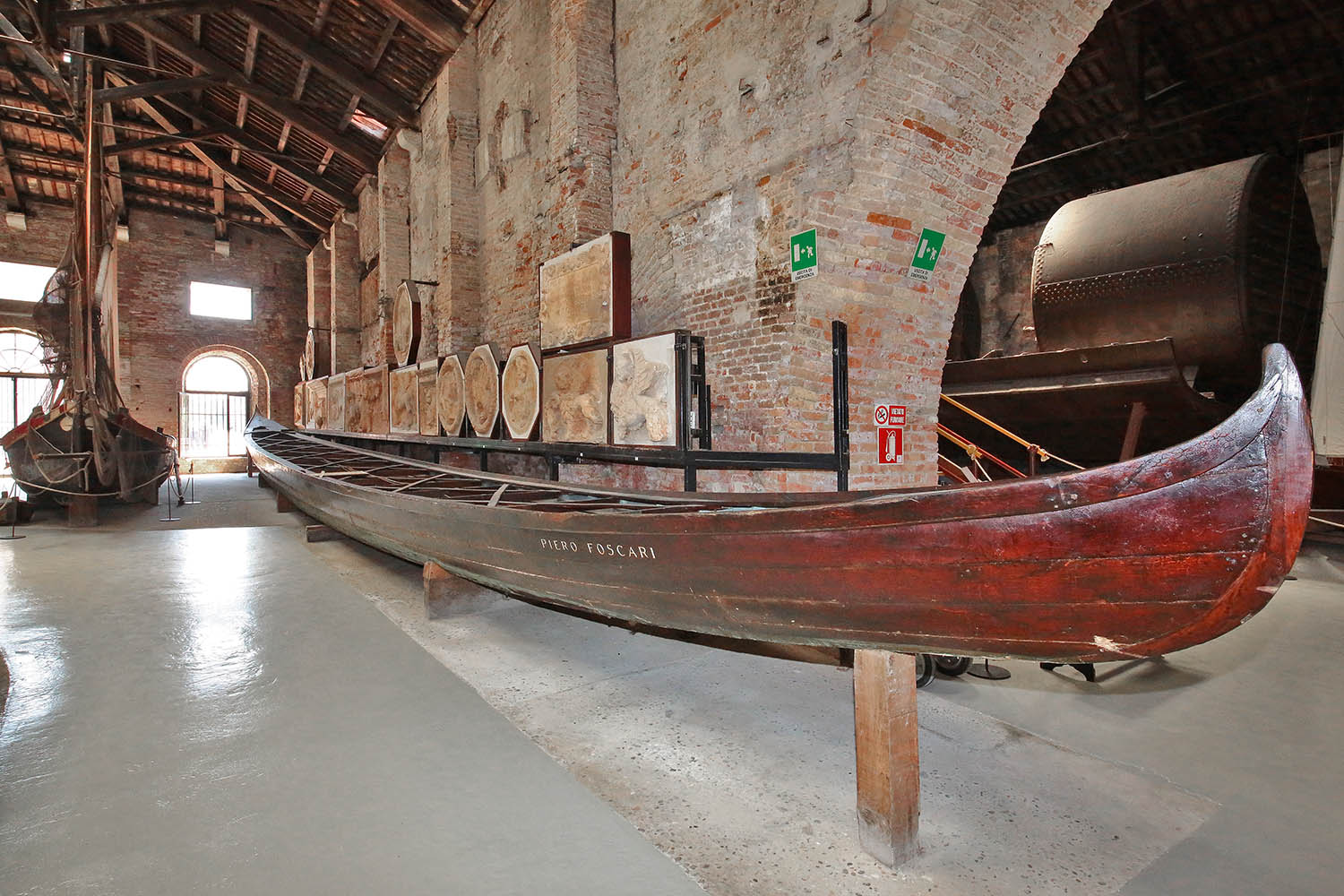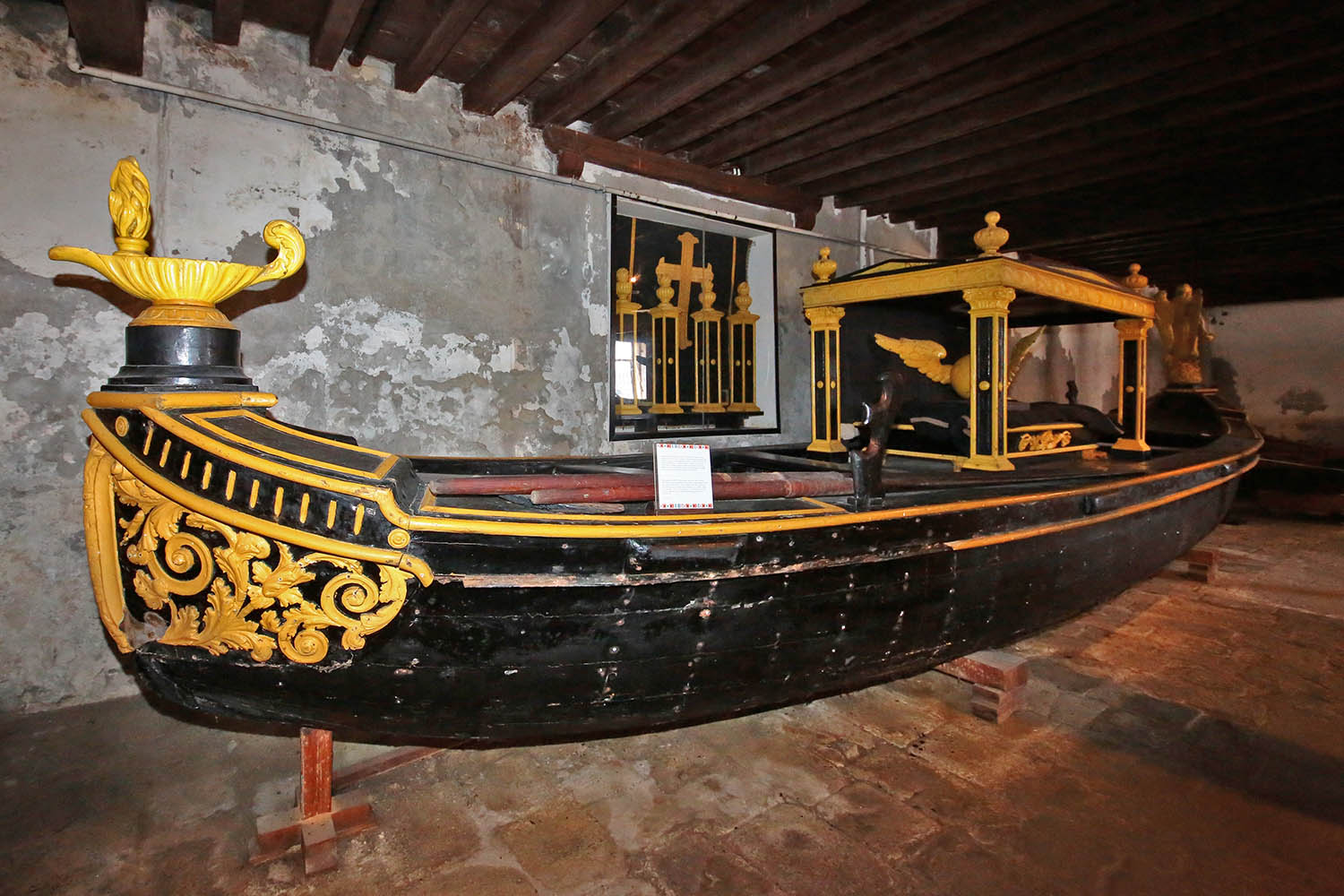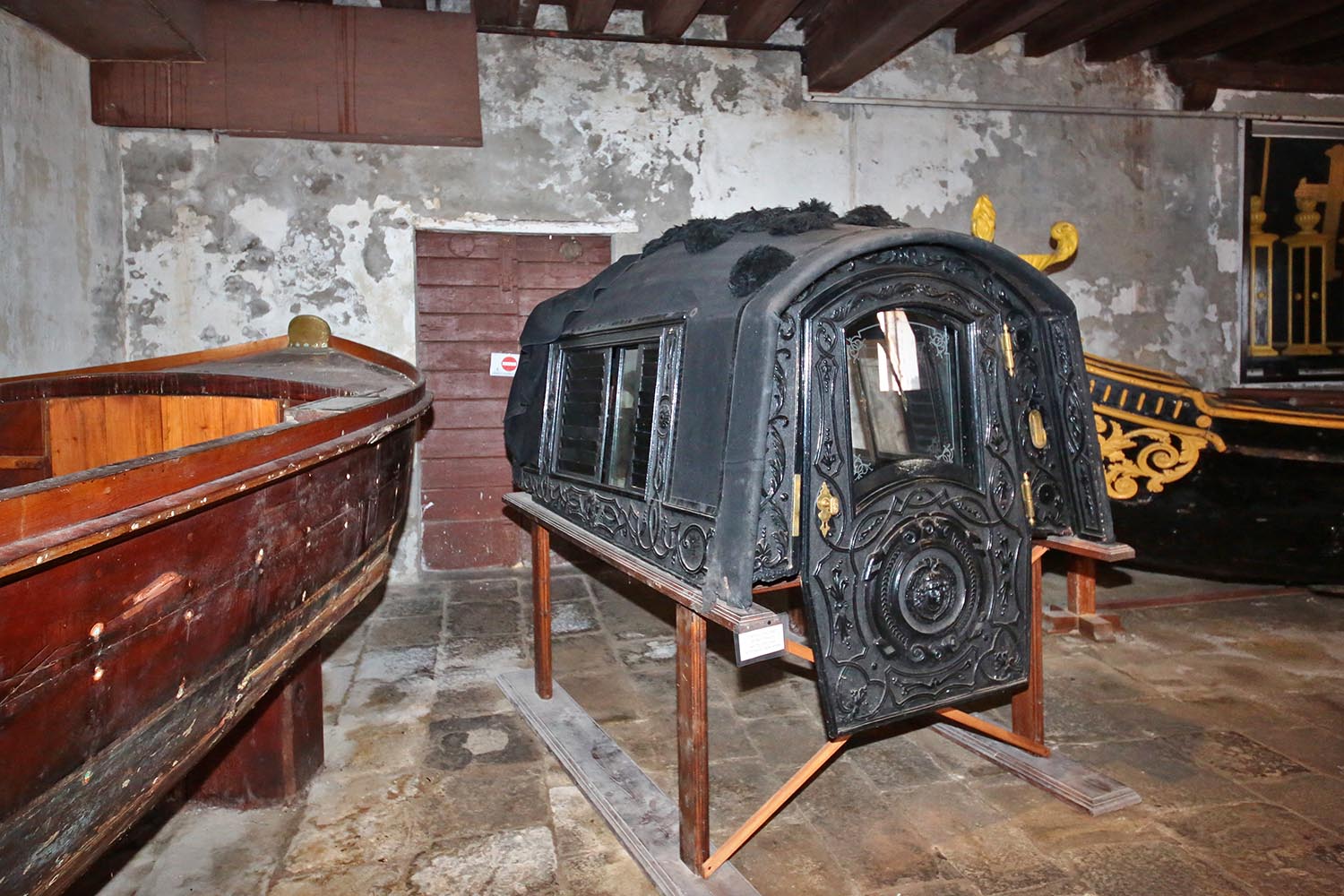The Arsenal of Venice, the beating heart of the economy of the Serenissima Republic and “officina de e maravegie” (“workshop of wander”) known throughout Europe for its modern ability to build and arm the Venetian fleet, is still today a testament of great value to the deep bond of the city with the sea. Complex and articulated site that from the sixteenth century factories, developed around the Darsena Grande, has moved in the Northern area, during the following centuries, it is itself museum for the number of ‘stories’ that each of its stones and its buildings tell.
Within this immense walled area – which covers one fifth of the entire urban area of Venice and which for many centuries has been a sort of ‘forbidden city’ – there are some pavilions where the Italian Navy preserves for museum purposes a collection of boats that testify to the different means that have crossed the lagoon with the most diverse functions and, at the same time, tell also a segment of the history of the local – civil and military – navy.
The so-called “Ships Pavilion”, attached to the Military Naval Historical Museum, located along the Tana canal, consists of three serially arranged units, and of a fourth one, of similar size, orthogonal to the first ones.
[one_half]
[/one_half]
[one_half_last]
[/one_half_last]
Museum installations at the Padiglione delle Navi. (© Vela Spa)
The building was built in the mid-sixteenth Century as an oars workshop and storage facility. Shortly after its completion in 1577, it was temporarily adapted to house the Great Council, the main government body of the city, following the disastrous fire that had destroyed much of the Palazzo Ducale, making it useless for a long time. The rooms basically retained their function of specialized workshop for the production of oars, supported by a blacksmith workshop and storage spaces, until the mid-nineteenth Century.
[one_half]
[/one_half]
[one_half_last]
[/one_half_last]
Museum installations at the Padiglione delle Navi. (© Vela Spa)
Following the reorganization of the Arsenal started after 1866, when Venice was annexed to the Kingdom of Italy, the premises were used as storehouses and workshops by the Military Engineers. In this period the roofing was restored, with the introduction of an interesting bidirectional system of iron ties which integrated the wooden roof trusses.
Since 1980, the area of the oars workshops has been known by the name of “Ships Pavilion”. It houses vessels of great historical importance as an annex of the museum.
Support Boat for divers, 1890. (© Vela Spa) Very robust hull, built in the Arsenal of Venice for the use of divers: its structure is in fact adequate for underwater activities.
Sandolo da schiòpo (schiopòn), mid 20th century. (© Vela Spa) The sandoli are a “family” of boats in the Venetian lagoon of easy and fast rowing. The specimen represents the model used to hunt the birds resting on the water, and takes its name from the long spur of 3 or 4 meters (in Venetian schiòpo or schiopón) that was fixed to the central beam and resting on the bow.
Steam boilers triple expansion of the Elettra pitch, 1904. (© Vela Spa) The elegant yacht was designed by Cox and King engineers of London at the request of the Archduke of Austria Carlo Stefano; is called Rovenska in memory of the town on the island of Losinj, where the Archduke owned a luxurious villa. Purchased by the British in 1910, it was used during the First World War in the English Channel as a patrol ship and for escort. Auctioned in 1919, it was bought by Guglielmo Marconi who transformed it into a laboratory ship equipped with transmitters, receivers and masts for the antennas; the Elettra was born, a mobile station for his experiences on radio waves, and from which he transmitted the famous impulse beyond the Atlantic. At his death in 1937 the ship was bought by the Italian Ministry of Posts and Telecommunications and, with the entry into the war of Italy, transferred to Trieste. Following the subsequent acquisition by the Germans, all the radio equipment and instruments used by Marconi were disembarked and packed in 19 cases, almost all sent to the Museum of Science and Technology in Milan. The Elettra was then bombed and sunk in 1944 near Zara where it remained semi-submerged up in 1962, when Marshall Tito returned it to Italy. In 1977 the ship was sectioned into sections, transferred to various locations for museum purposes.
Gondola, first half of the 20th century. (© Vela Spa) Used “for service” by the Navy. On the boat is a felze, a characteristic removable cover that provided shelter from the elements.
Scalé Reale, first half of the 19th century. (© Vela Spa) Splendid example of parade ship, was built by Venetian workers inside the Arsenal, probably during the Habsburg domination; the boat was used in the San Marco basin on the occasion of festivities, historical and social events in Venice. Its last exit was in 1959, to welcome in Venice the coffin of Pope Pius X, former patriarch of Venice.
Gondola, late 19th century. (© Vela Spa) Among those conserved in the Museum is surely the oldest gondola, with carvings and decorations.
Gondola Disdótona “Piero Foscari”, 1926. (© Vela Spa) Gondolona 18 oars, built for the Querini Canottieri rowing Club, is the largest built at the time, and was given the name Piero Foscari, at the time the president of the company. It participated in all the parades of the Historical Regatta and some lavish events organized for the arrival in Venice of illustrious guests such as the procession of 1946 in honor of Queen Elizabeth II of England and the parade of September 16, 1972 to welcome Pope Paul VI.
Bragozzetto “Astemio”, 1948. (© Vela Spa) Far smaller than the bragozzi used in deep-sea fishing, the Bragozzetti practiced different forms of fishing in coastal waters, with daily return to land, and with crew almost always composed of a single family unit. Characteristic features of the bragozzi are the lively pictorial decorations of the hull: sacred subjects, symbols of peace such as doves, geometric designs, etc.. On the sails were painted bands and emblems that served as a clear sign of recognition, to identify the owner at a considerable distance. Traditional are also the sacred scenes painted in some parts of the boat. These representations, typical of the seafaring populations, had an invocative and superstitious value.
Funeral boat, about 1870. (© Vela Spa) In the second half of the 19th century a municipal arrangement of Venice provides for the construction of 4-5 rowing boats used for the funerals in Venice from the city to the cemetery of San Michele. Is the only surviving example, used until 1940 to transport the coffins of the arsenalotti (the Arsenal workers) from the church of San Biagio dei Marinai to the cemetery of Venice. The boat was led by four rowers, whose uniform had the same colors of the boat.
Fèlze for gondola, beginning of the 20th century. (© Vela Spa) Protection cabin for gondola passengers.
Information
PADIGLIONE DELLE NAVI
Rio della Tana Castello 2162 c, Venezia
Call center: +39.041.2424
Web site: www.veneziaunica.it
Head Image: Traditional boats at the Padiglione delle Navi. (© Vela Spa)
Padiglione delle Navi del Museo Storico Navale della Marina Militare
L’Arsenale di Venezia, cuore pulsante dell’economia della Repubblica Serenissima e “officina de e maravegie” nota in tutta Europa per la sua modernissima capacità di costruire e armare la flotta veneziana, è ancora oggi una testimonianza di inestimabile valore del legame profondo della città con il mare. Sito complesso e articolato che dalle fabbriche cinquecentesche, cresciute intorno alla Darsena Grande, si è sviluppato nei secoli successivi nell’area Nord, è esso stesso “museo” per il numero di ‘storie’ che ogni sua pietra e ogni suo edificio raccontano.
All’interno di questa immensa area murata – che copre un quinto dell’intera superficie urbana di Venezia e che per molti secoli è stata una sorta di ‘città proibita’ – vi sono alcuni padiglioni dove la Marina Militare Italiana conserva ad uso museale una collezione di imbarcazioni che testimoniano i diversi mezzi che hanno solcato la laguna con le funzioni più diverse e, al tempo stesso, raccontano anche un pezzo della storia della marineria locale, civile e militare.
Il cosiddetto “Padiglione delle Navi”, annesso al Museo Storico Navale della Marina Militare, situato lungo il rio della Tana, è costituito da tre corpi di fabbrica disposti in modo seriale e da un quarto, di analoghe dimensioni, ortogonale ai primi.
Alcuni allestimenti museali all’interno del Padiglione delle navi. (© Vela Spa)
Realizzato alla metà del Cinquecento per la funzione di officina e deposito dei remi, l’edificio, poco dopo la sua realizzazione, nel 1577, venne adattato temporaneamente a sede del Maggior Consiglio, il principale organo di governo della città, a seguito del rovinoso incendio che rese inagibile Palazzo Ducale per molto tempo. Le sale mantennero sostanzialmente la funzione di falegnameria specializzata per i remi, affiancata da un’officina febbrile e da spazi di deposito, fino alla metà dell’Ottocento.
Alcuni allestimenti museali all’interno del Padiglione delle navi. (© Vela Spa)
A seguito degli interventi di riordino dell’Arsenale avviati dopo il 1866, anno in cui Venezia fu annessa al Regno d’Italia, i locali furono destinati a magazzini e officine del Genio. In quel periodo vi fu un intervento di restauro delle coperture, con l’introduzione di un interessante sistema bidirezionale di tiranti in ferro che integravano le incavallature lignee del tetto.
Dal 1980 gli spazi delle officine dei remi ospitano, con la denominazione di Padiglione delle Navi, imbarcazioni di grande rilievo storico e costituiscono un ampliamento della sede principale del museo.
Barca appoggio per palombari, 1890. (© Vela Spa)Scafo particolare, molto robusto, fu costruito nell’Arsenale di Venezia per uso dei palombari, e la sua struttura si presenta appunto adeguata alle attività subacquee.
Sandolo da schiòpo (schiopòn), metà del XX secolo. (© Vela Spa)I sandoli sono una “famiglia” di imbarcazioni della laguna veneziana di facile e veloce conduzione a remi. L’esemplare esposto rappresenta il modello usato per la caccia ai volatili in riposo sull’acqua, e prende il nome dalla lunga spingarda di 3 o 4 metri che veniva fissata al baglio centrale (trasto) e poggiante sulla prua.
Caldaie a vapore a triplice espansione del Piroscafo Elettra, 1904. (© Vela Spa)L’elegante yacht fu progettato dagli ingegneri Cox e King di Londra su richiesta dell’Arciduca d’Austria Carlo Stefano e chiamato Rovenska a ricordo della località, nell’isola di Lussino, dove l’Arciduca possedeva una lussuosa villa. Acquistato dagli inglesi nel 1910, venne utilizzato durante la prima Guerra Mondiale nello stretto della Manica come nave da pattuglia e per la scorta.Messo all’asta nel 1919 fu acquistato da Guglielmo Marconi che lo trasformò in nave laboratorio dotata di trasmittenti, riceventi e alberi per le antenne; nacque così l’Elettra, una stazione mobile per le sue esperienze sulle onde radio, e da cui trasmise il famoso impulso al di là dell’Atlantico. Alla sua morte nel 1937 la nave fu acquistata dal Ministero delle Poste e Telecomunicazioni e, con l’entrata in guerra dell’Italia, trasferita a Trieste. A seguito della successiva acquisizione da parte dei tedeschi, tutte le apparecchiature radio e gli strumenti utilizzati da Marconi vennero sbarcati e imballati in 19 casse, quasi tutte spedite al Museo della Scienza e della Tecnica di Milano.L’Elettra venne poi bombardata e affondata nel 1944 vicino a Zara dove rimase semisommersa fino al 1962, quando il maresciallo Tito la restituì all’Italia. Nel 1977 la nave venne sezionata in tronconi, trasferiti in varie località a scopo museale.
Gondola, prima metà del XX secolo. (© Vela Spa)Usata “per servizio” dalla Marina Militare. Sull’imbarcazione è appoggiato un felze, caratteristica copertura asportabile che forniva riparo dalle intemperie.
Scalé Reale, prima metà del XIX secolo. (© Vela Spa)Splendido esempio di naviglio da parata, fu costruito da maestranze veneziane all’interno dell’Arsenale, probabilmente durante la dominazione Asburgica; l’imbarcazione veniva usata in bacino di San Marco in occasione di festività, eventi storici e sociali di Venezia. L’ultima uscita è stata nel 1959, per accogliere a Venezia il feretro di papa Pio X, già patriarca di Venezia.
Gondola, fine del XIX secolo. (© Vela Spa)Tra quelle conservate nel Museo è sicuramente la gondola più antica, con intagli e decori pregiati.
Gondola Disdótona “Piero Foscari”, 1926. (© Vela Spa)Gondolona a 18 remi, realizzata per la Società Canottieri Querini, è la maggiore al momento costruita, e le è stato dato il nome Piero Foscari, all’epoca il presidente della Società. Essa partecipò a tutti i cortei della Regata Storica e ad alcuni fastosi eventi organizzati per l’arrivo a Venezia di ospiti illustri come il corteo del 1946 in onore della Regina Elisabetta II d’Inghilterra e il corteo del 16 settembre 1972 per accogliere il Papa Paolo VI.
Bragozzetto “Astemio”, 1948. (© Vela Spa)Ben più piccoli dei bragozzi impiegati nella pesca d’altura, i bragozzetti praticavano diverse forme di pesca nelle acque litoranee, con quotidiano rientro a terra, e con equipaggio composto quasi sempre da un solo nucleo famigliare. Una caratteristica dei bragozzi sono le vivaci decorazioni pittoriche dello scafo, raffiguranti figure alate che suonano la tromba, soggetti sacri, simboli di pace come colombe, disegni geometrici. Sulle vele venivano dipinti bande ed emblemi quale chiaro segno di riconoscimento, per identificare il proprietario a notevole distanza. Tradizionali sono anche le scene sacre dipinte in alcune parti della barca: sulle bande interne di poppa è rappresentata una “Crocifissione” mentre su quelle di prua si può vedere la “Pesca miracolosa”. Tali raffigurazioni, tipiche delle popolazioni marinare, avevano valore invocativo e scaramantico.
Barca dei morti (imbarcazione per trasporti funebri), 1870 circa. (© Vela Spa)Nella seconda metà dell’Ottocento una disposizione comunale di Venezia prevede la realizzazione di 4-5 imbarcazioni a remi adibite al trasporto funebre per i veneziani dalla città al cimitero di San Michele. Unico esemplare superstite, è stato utilizzato fino al 1940 per trasportare le bare degli arsenalotti (i lavoratori dell’Arsenale) dalla chiesa di San Biagio dei Marinai al cimitero di Venezia. L’imbarcazione era condotta da quattro vogatori, i necrofori, la cui divisa aveva gli stessi colori della barca.
Fèlze per gondola, inizio del XX secolo. (© Vela Spa)Cabina di protezione per i passeggeri della gondola.
Informazioni
PADIGLIONE DELLE NAVI
Rio della Tana Castello 2162 c, Venezia
Call center: +39.041.2424
Web site: www.veneziaunica.it
Head Image: Imbarcazioni tradizionali al Padiglione delle Navi. (© Vela Spa)


